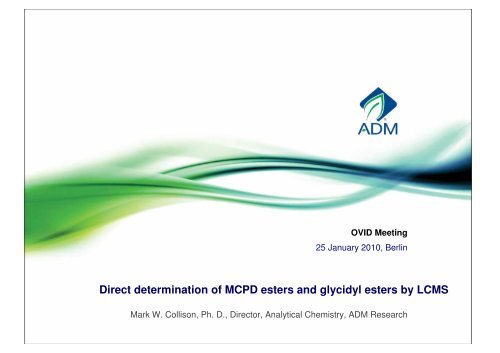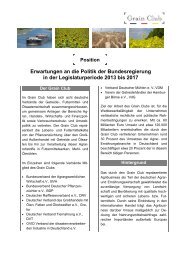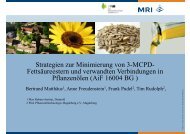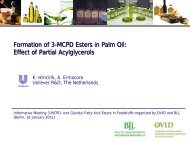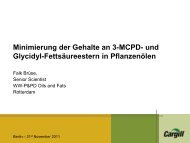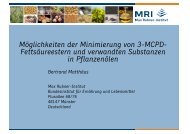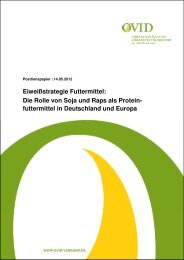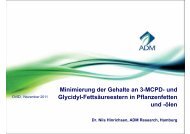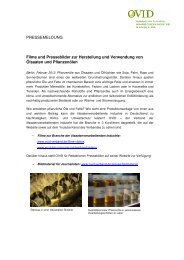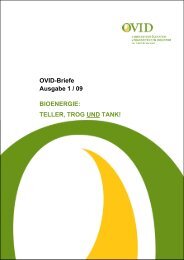Direct determination of MCPD esters and glycidyl esters by ... - OVID
Direct determination of MCPD esters and glycidyl esters by ... - OVID
Direct determination of MCPD esters and glycidyl esters by ... - OVID
Create successful ePaper yourself
Turn your PDF publications into a flip-book with our unique Google optimized e-Paper software.
WIA YOUTH ELIGIBILITYDepartment: Office <strong>of</strong> Economic & Workforce Effective Date: Oct 1, 2009DevelopmentPolicy/Procedure #: WIA101Y Supersedes: July 1, 2009OverviewWIA eligibility <strong>determination</strong> is required when a job seeker needs staff-assisted servicesto obtain or retain employment. As a job seeker moves through the service levels,additional requirements must be met to show that the job seeker is appropriate for thenext level <strong>of</strong> service, <strong>and</strong> requires that level <strong>of</strong> service to obtain or retain employment.WIA Orientation- All participants shall go through a WIA orientation prior to eligibility<strong>determination</strong>. The provider shall be made aware <strong>of</strong> the all the elements <strong>and</strong> paperwork<strong>of</strong> the WIA program in order to prepare individuals who are interested in receiving WIAservices.Basic Eligibility RequirementsThe basic requirements for WIA eligibility are as follows:• 14 -21 years <strong>of</strong> age (14 -24 for ARRA funded services);• A citizen or noncitizen authorized to work in the U.S., as required according to I-9 Employment Eligibility Verification; <strong>and</strong>• Meet Military Selective Service registration requirements (males only). All maleswho are at least 18 years <strong>of</strong> age <strong>and</strong> born after December 31, 1959, <strong>and</strong> who arenot in armed services on active duty, must be registered for Selective Service.Additional Requirements for YouthThe eligibility definitions for the WIA Youth Programs will apply in the <strong>determination</strong> <strong>of</strong>eligibility for registrants requesting services under Title IB <strong>of</strong> the Workforce InvestmentAct (WIA).• Ages 14 – 21 (or 14 - 24 for ARRA funded services only)• Low income (see WIA Income Criteria <strong>and</strong> Technical Assistance Guide foradditional information)• Additional Barrier: Deficient in basic literacy skills; A school dropout; Homeless, a runaway, or a foster child;
TOF-LCMS Method for <strong>MCPD</strong> <strong>esters</strong> <strong>and</strong> <strong>glycidyl</strong> <strong>esters</strong>•<strong>MCPD</strong> <strong>esters</strong> do not readily ionize to MH+ ions <strong>by</strong> eitherESI or APCI•Current approach used previously for diglycerides [1]•Low concentration <strong>of</strong> sodium acetate in the mobile phaseallows ESI ionization <strong>and</strong> detection <strong>of</strong> sodiated ions[MNa+]•High resolution TOF-MS for detection allowed elimination<strong>of</strong> interferences for certain <strong>MCPD</strong> <strong>esters</strong>.-Eliminated <strong>by</strong> setting m/z resolution to 50 ppm (±0.016da)[1] Hannah L. Callender, Jeffrey S. Forrester, Pavlina Ivanova, Anita Preininger,Stephen Milne, <strong>and</strong> H. Alex Brown, “Quantification <strong>of</strong> Diacylglycerol Species fromCellular Extracts <strong>by</strong> Electrospray Ionization Mass Spectrometry Using a LinearRegression Algorithm” Anal. Chem. 2007, 79, 263-2725
LC-TOFMS•Detects both mono- <strong>and</strong> di-<strong>esters</strong> <strong>of</strong> <strong>MCPD</strong>•Limit <strong>of</strong> quantitation for total <strong>MCPD</strong> <strong>esters</strong> ~500 µg/kg(~100 µg/kg <strong>MCPD</strong> equivalent concentration)•Method also optimized for detection <strong>of</strong> <strong>glycidyl</strong> <strong>esters</strong>•Limit <strong>of</strong> quantitation for total <strong>glycidyl</strong> <strong>esters</strong> ~100 µg/kg(~20 µg/kg glycidol equivalent concentration)6
LC <strong>and</strong> TOF-MS conditions• Methanol-Sodium Acetate - Methanol containing 0.26 mM sodium acetatewas prepared <strong>by</strong> adding 21.3 mg sodium acetate to 1 liter methanol.• HPLC Mobile Phase A - 90% methanol 10% acetonitrile with 0.026 mMsodium acetate. Mix 100 mL Methanol-Sodium Acetate, 800 mL methanol<strong>and</strong> 100 mL acetonitrile.• HPLC Mobile Phase B - 80% methylene chloride 10% methanol 10%acetonitrile with 0.026 mM sodium acetate. Mix 100 mL Methanol-SodiumAcetate, 800 mL methylene chloride <strong>and</strong> 100 mL acetonitrile.• ISTD solution: 2030 µg/mL dioleyl-d5-<strong>MCPD</strong> <strong>and</strong> 180 µg/mL <strong>glycidyl</strong> 31dpalmitatein HPLC Mobile B• Sample Preparation:-In a 12 x 32 HPLC vial, accurately weigh 1 drop (~20-25 mg) oil-Add 975 µL ISTD Solution.8
LC <strong>and</strong> TOF-MS conditions• HPLC Column: Phenomenex Luna 3 µm C18 ,100Å 50 x 3.0 mm.• Flow Rate - 0.25 mL / min.• TOF-MS –• Agilent 6210 TOF-MS upgraded to 4 GHz- ESI at 3.5 kV- Gas Temp. 300°C- Drying Gas 5 L/min.- Nebulizer Pressure 50 psi- Mass Range 300 to 700 m/zGradient ProgrammingRun Time % B0 min. 05 min. 015 min. 6516 min. 10020 min. 100• Polarity Positive, Instrument Mode 4 GHz, Data Storage - Centroid• Monoheptadecanoin <strong>and</strong> Dinonadecanoin as Mass Reference Ions9
Compound Formula m/z [M+Na(+)]Palmitic Acid Glycidol Ester C19H36O3 335.25622Stearic Acid Glycidol Ester C21H40O3 363.28752Oleic Acid Glycidol Ester C21H38O3 361.27187Linoleic Acid Glycidol Ester C21H36O3 359.25622Linolenic Acid Glycidol Ester C21H34O3 357.24057d31-Palmitic Acid Glycidol Ester Internal St<strong>and</strong>ard C19H5D31O3 366.45025Palmitic Acid <strong>MCPD</strong> monoester C19H37ClO3 371.23289Stearic Acid <strong>MCPD</strong> monoester C21H41ClO3 399.26419Oleic Acid <strong>MCPD</strong> monoester C21H39ClO3 397.24854Linoleic Acid <strong>MCPD</strong> monoester C21H37ClO3 395.23289Linolenic Acid <strong>MCPD</strong> monoester C21H35ClO3 393.21724Palmitic Acid-Oleic Acid-<strong>MCPD</strong> diester C37H69ClO4 635.47821di-Palmitic Acid <strong>MCPD</strong> Diester C35H67ClO4 609.46256di-Oleic Acid <strong>MCPD</strong> diester C39H71ClO4 661.49386Palmitic Acid-Linoleic Acid <strong>MCPD</strong> diester C37H67ClO4 633.46256Oleic Acid-Linoleic Acid <strong>MCPD</strong> diester C39H69ClO4 659.47821Palmitic Acid-Stearic Acid <strong>MCPD</strong> diester C37H71ClO4 637.49386Oleic Acid-Stearic Acid <strong>MCPD</strong> Diester C39H73ClO4 663.50951di-Linoleic Acid <strong>MCPD</strong> diester C39H67ClO4 657.46256Linoleic Acid-Stearic Acid <strong>MCPD</strong> diester C39H71ClO4 661.49386di-Stearic Acid <strong>MCPD</strong> diester C39H75ClO4 665.52516di-Linolenic Acid <strong>MCPD</strong> diester C39H63ClO4 653.43126Oleic Acid-Linolenic Acid <strong>MCPD</strong> diester C39H67ClO4 657.46256Linoleic Acid-Linolenic Acid <strong>MCPD</strong> diester C39H65ClO4 655.44626Palmitic Acid-Linolenic Acid <strong>MCPD</strong> diester C37H65ClO4 631.44691Stearic Acid-Linolenic Acid <strong>MCPD</strong> diester C39H69ClO4 659.47821d5-<strong>MCPD</strong> Di-Oleic Acid Ester Internal St<strong>and</strong>ard C39H66D5ClO4 666.5252410
571 ppb Glycidyl Palmitate485 ppb Glycidyl Stearate568 ppb Glycidyl Oleate478 ppb Glycidyl Linoleate444 ppb Glycidyl Linolenate11
5693 ppb 3-<strong>MCPD</strong> Monopalmitate2338 ppb 3-<strong>MCPD</strong> Monostearate12730 ppb 3-<strong>MCPD</strong> Monooleate10396 ppb 3-<strong>MCPD</strong> Monolinoleate1516 ppb 3-<strong>MCPD</strong> Monolinolenate12
7180 ppb 3-<strong>MCPD</strong> Palmitic-Palmitic Diester4347 ppb 3-<strong>MCPD</strong> Oleic-Oleic Diester10981 ppb 3-<strong>MCPD</strong> Oleic-Linoleic Diester6935 ppb 3-<strong>MCPD</strong> Linoleic-Linoleic Diester2022 ppb 3-<strong>MCPD</strong> Linoleic-Linolenic Diester2030 ppb d5-3-<strong>MCPD</strong> Oleic-Oleic Diester (ISTD)13
732 ppb 3-<strong>MCPD</strong> Palmitic-Oleic Diester924 ppb 3-<strong>MCPD</strong> Palmitic-Linoleic Diester251 ppb 3-<strong>MCPD</strong> Oleic-Stearic Diester147 ppb 3-<strong>MCPD</strong> Linolenic-Linolenic Diester135 ppb 3-<strong>MCPD</strong> Palmitic-Linolenic Diester14
Typical St<strong>and</strong>ard CurveGL, ng/mL 4.79 11.96 23.93 47.85 119.63 239.25 478.515
Results for Commercial Refined Oils•<strong>MCPD</strong> mono<strong>esters</strong> are never found in deodorizedoils. This means that glycidol is not likely to be theprecursor <strong>of</strong> <strong>MCPD</strong> <strong>esters</strong> in oils.•<strong>MCPD</strong> di<strong>esters</strong> have been not found incommercial vegetable oils other than somesamples <strong>of</strong> palm oil.•The DGF test does not accurately predict theamount <strong>of</strong> <strong>MCPD</strong> <strong>esters</strong> in oil samples.16
DGF Method compared to LCMS methodSample IDDGFmethodrun atSGSTotal<strong>MCPD</strong>Mono<strong>esters</strong>mg/kg(DL=1)Total<strong>MCPD</strong>Di<strong>esters</strong>mg/kg(DL=0.5)<strong>MCPD</strong>Equiv.<strong>by</strong> LCMSmg/kgTotalGlycidylEstersmg/kg(DL=0.1)GlycidolEquiv.mg/kgSample A : RBD Palm oil 7.74 nd 6.1 1.2 18.6 5.0Sample A after ADM TreatmentProcess2.85 nd nd 0.0 nd 0.0Sample B, Commercial Oil Blend 3.64 nd nd 0.0 9.9 2.7Sample B after ADM TreatmentProcess1.83 nd nd 0.0 nd 0.0DGF method predicts much higher <strong>MCPD</strong> concentrations than LCMSwhen <strong>MCPD</strong> <strong>esters</strong> are present.DGF Method still gives positive results even when <strong>MCPD</strong> <strong>and</strong><strong>glycidyl</strong> <strong>esters</strong> are not present.17
<strong>MCPD</strong> Esters can form from contact with hydrochloricacidSample: RBD Corn Oil with~20 mg/kg added <strong>glycidyl</strong> stearateGE (ppm)3-<strong>MCPD</strong>di<strong>esters</strong>(ppm)Control - no acid wash 24.4 ndAcetic acid wash 23.1 ndHydrochloric acid wash 20.1 40.8ADM Treatment Process nd ndConditions <strong>of</strong> acid treatment: 0.1 v/wt% acid, 2 min shear mix,60 min stir mix, 70 C, water wash to neutral, deodorized afterwashing18
<strong>MCPD</strong> Esters can form from hydrochloric acid treatedadsorbentsSample <strong>of</strong> RB Palm Oil with~20 mg/kg added <strong>glycidyl</strong> stearateGlycidyl Esters(mg/kg)<strong>MCPD</strong> di<strong>esters</strong>(mg/kg)Control (No treatment) 18.8 nd10% Magnesol XL, 110 C, 30 min 35.1 nd10% Silica gel, 110C, 30 min 16.9 nd10% alumina, acidic *, 110 C, 30 min 21.4 73.210% acid washed carbon *, 110 C, 30 min 22.2 215.6* manufacturers confirmed that HCl was used in the acid washingNote that <strong>MCPD</strong> increased without a decrease in <strong>glycidyl</strong> <strong>esters</strong>.Glycidyl <strong>esters</strong> were not converted to <strong>MCPD</strong>19
Glycidyl <strong>esters</strong>•Glycidyl <strong>esters</strong> were found in significant quantitiesin some commercial vegetable oils.•Diglyceride content seems to correlate somewhatwith <strong>glycidyl</strong> ester content. High diglyceridecontent in oils predisposes them to formation <strong>of</strong><strong>glycidyl</strong> <strong>esters</strong>20
Conclusions• The harsh chemistry <strong>of</strong> the DGF method createsincorrect results in the analysis <strong>of</strong> <strong>MCPD</strong> <strong>and</strong><strong>glycidyl</strong> <strong>esters</strong>.• Chemistry capable <strong>of</strong> transesterifying oils needs tobe avoided in analysis <strong>of</strong> <strong>MCPD</strong> <strong>and</strong> <strong>glycidyl</strong> <strong>esters</strong>.• <strong>Direct</strong> analysis <strong>by</strong> LCMS looks extremely promising.• <strong>MCPD</strong> <strong>esters</strong> can form from contact withhydrochloric acid <strong>and</strong> from acid washed absorbents.• Glycidyl <strong>esters</strong> are widely present in vegetable oils.Glycidyl <strong>esters</strong> seem to be a much more widespreadissue than <strong>MCPD</strong> <strong>esters</strong>.• Glycidyl <strong>esters</strong> <strong>and</strong> <strong>MCPD</strong> <strong>esters</strong> can be greatlyreduced <strong>by</strong> processing.22


